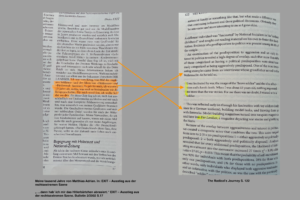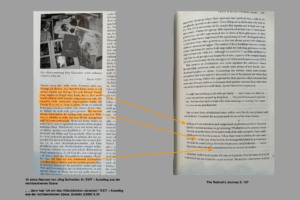Biographical clones and other anomalies – Review: „The Radical’s Journey.
Review: „The Radical’s Journey. How German Neo-Nazis Voyaged to the Edge and Back“
In 2020, the book „The Radical’s Journey“ was initially praised in professional circles. Former right-wing extremist Tanja Privenau has now looked at the book in greater depth and has gained some surprising insights. She concludes it provides answers that raise even more questions.
By Tanja Privenau.
Published by one of the world’s leading publishing houses, the study by two renowned scholars, Prof. Dr. Arie W. Kruglanski and Prof. Dr. David Webber, together with Daniel Köhler, was received with a great deal of praise and goodwill by distinguished international extremism and terrorism experts. „This book sets the new standard for evidence-based terrorism research! Based on interviews with former Neo-Nazis, it shows how they joined, stayed, and eventually left this movement. A must read for all people interested in radical movements!“, said Marc Sagemen. Prof. Dr. Preben Bertelsen also emphasizes: “An important volume for policymakers and practitioners. Based on semi-structured interviews with 43 former German right-wing extremists, this book offers comprehensive insight into the three phases of radicalization, extremist activities, and the disengagement of German right-wing extremists. We now have an in-depth psychological analysis of the extremist’s journey into extremism and back to mainstream society”. Other experts expressed similar sentiments.
Since exiting in 2005, I have taken an interest in scientific findings on the topic of right-wing extremism. I have taken part in several research projects or supported the work of journalists, as I find it important to use my experience to contribute to understanding why young people turn to right-wing extremism and what society can do to encourage them to turn away from it.
As a result, I became aware of the publication of The Radical’s Journey. Not only because it promised an overview of the current situation of groups and movements and internal perspectives on former right-wing extremists, but also because it offered a look at the situation in Germany from which I hoped to gain some insights.
The Radical’s Journey – An Overview
The book is divided into ten chapters, with chapters 1 to 3 dealing with the development of right-wing extremism as well as its specific manifestations and deradicalization programs in Germany. This part of the book provides an incomplete list of groups or movements that are active in Germany. After a section concerning methodology, which explains the 3N model on which the analysis is based, there follows an analysis of interviews with people who have left the right-wing extremist scene. This chapter then goes into more detail about individual development or radicalization phases. After a brief section dealing with classification and methodological principles, the authors divided the chapter into four phases: Entry, Affiliation, Problems and Exit, and Life After.
The book concludes with a summarizing classification. In the final chapter, the authors discuss the extent to which the findings resulting from the evaluation of the preceding chapters can be generalized, i.e. the extent to which they can apply beyond the German context and Germany’s historical experience of National Socialism. There are also insights into the music scene and comments on what can be gained from this analysis concerning reintegration measures.
The interviews
I read the section dealing with the evaluation of interviews with particular interest. Not only because of my own biographical experience, but also because I feel that the perspective of dropouts is underrepresented in the German academic landscape. The heart of the book was to be its empirical basis consisting of 36 interviews selected, according to specific criteria, from the archive of the German Institute on Radicalization and De-Radicalization Studies. All of the interviews were said to have been collected or supervised by the director of GIRDS, Daniel Köhler (p. 94). According to the study, the interviewees were identified and contacted between 2010 and 2014: they were neither clients of the interviewer, nor had they any personal relations or conflicts of interest with him (ibid.).
My first impression gave me hope that I would discover substantiated findings, especially due to the high number of participants in the interviews. I had already met the afore-mentioned director of the institute, Daniel Köhler. After reading the interviews for the first time, I noticed that some of the narratives seemed familiar to me, especially regarding certain situations and experiences of the former right-wing extremists interviewed. Which is actually not surprising, since it is possible to read biographies of former right-wing extremists in a variety of settings. I was surprised, however, to find a biography in the book that coincided with my own. But it couldn’t be the case that this was in fact one of the interviews that I had given at some point. After all, no one had asked my permission for the interview to be used in this book. Unfortunately, the quotes in the book were also not marked in any assignable way, which makes it difficult to source them. Since the information provided is anonymous, I initially thought no more of it and, at first, assumed that it was just a very surprising coincidence.
On the trail of the anomaly
With this in mind, I continued to devote myself to the chapter concerning the evaluation of the interviews. Again and again, passages seemed familiar to me; finally, I counted six passages that I knew from my own biography. But there were also other accounts from former right-wing extremists that I had heard about or that I had met myself. Most of them were in the context of the action group EXIT-Germany. But what stopped me in my tracks was the following passage:
“… a gun was more less put on my head and I was told that if I didn`t (kidnap my grandchild), then they would do it …. I drove to Berlin, which is a city that I have bad memories of. You see we fled the former East Germany, I really didn’t want to go there and that was a problem for me, an indescribable problem. Well, I drove there nonetheless and took my grandson. And then we were on the run, which was absolutely terrible.”The Radical’s Journey S. 186
I recognized this passage also immediately, because this story is similar to that of person very well known to me: my mother. I was aware at that time that only one interview had been conducted for scientific purposes with her and that it was not publicly available. So I asked my mother – even though I already knew the answer – whether she had been interviewed for this book. This confirmed that she neither knew about the book nor about the possible inclusion of an interview conducted with her. The authors assure the readers, however, with reference to the evaluation and consent explanation of the following: “All interviewees were fully briefed about the research scope and use of the material.”. This would suppose a further, extraordinary, coincidence, if the events described indeed took place exactly as they had in my family.
Now my interest was aroused.
My Journey
I took a closer look at the interview passages and believed I could identify at least 14 people from the biographical narratives. I was in contact with some of them, so I approached them directly. Others, with whom I had no direct contact, I contacted through EXIT-Germany. In total, I contacted ten people. In the end, the result was clear: all ten people I thought I recognized and was able to contact confirmed my suspicion. They, too, were surprised at the identical similarity of the interview statements in the book and their own biographical narratives or statements. Some of the people at least knew the co-author Daniel Köhler personally, while others had never seen him in their lives. Another quotation that made a particular impression on me was from a person who immediately thought that she had recognized her own statement in a quote and told me that she, too, had only given one interview in which this passage was stated. She did not give any other biographical interviews beyond that. The interview dates from 2009, but this person has never met Mr. Köhler. In the book The Radical’s Journey it also says: “The interviewees were identified and contacted through snowball sampling (Atkins & Flint, 2001) between 2010 and 2014.“. This is another remarkable coincidence.
Together with some other former right-wing extremists, I now started to intensify my research, as we now wanted to know if there were more biographical clones.
Although the passages quoted had been translated, the biographical narratives were so striking that they could be easily sourced and, after translation, some could even be found in Google. The interviewees were able to reconstruct other sources themselves, as they had personally kept the interview transcripts in question.
Thus, together the other former right-wing extremists and I were able to see that some statements are notably similar to interview transcripts from the SAFIRE research project. These interviews were conducted at EXIT between 2011 and 2012. Mr. Köhler was partly involved in this. I know that because I was also involved. I am expressly stating here that, in the cases described, there are astonishing matches. They would need to be compared with the authors’ transcripts. In order to further clarify the reason for my astonishment, I have listed here, in extract, a comparison of the passages in tabular form.
Biographical clones
Every person is known to have a double. Statistically, there are supposed to be as many as seven. Ultimately, however, even this claim is not undisputed. Be that as it may, what was completely new to me was the concept that narratives and biographical experiences can also have their doppelgangers. But what really made an impression on us, was that some statements had their quote-double in a completely unexpected source. I found a quote-double in an interview with the Federal Agency for Civic Education (Bundeszentrale für politische Bildung – BpB) using Google – just like that. I found the interesting article at the BpB by simply entering three terms „former right-wing extremists; right-wing extremism; discussion forums“. Try it out! Under the title Rechtsextremismus ist der große Aberglaube unserer Zeit. Ein Gespräch mit dem NPD-Aussteiger und Mitarbeiter der Aussteigerinitiative EXIT (Right-wing extremism is the great superstition of our time. A conversation with the former NPD member and employee of the former right-wing extremists initiative EXIT) from 2004, a previous employee and former right-wing extremist describes the working methods of EXIT. He also discusses his own biography.
| “When I was really low, I came in touch with a website …. Intended to attract right-wing extremists and engage them in conversation. They have chat rooms and discussion forums. This is where I met a dropout from the left-wing extremist milieu who had experienced the same psychological issues himself. We started talking. The website is ideal for people who are on the edge of society or who are thinking further and want out.”
The Radical’s Journey S. 178-179 |
„Als ich in dem seelischen Tief war, bekam ich Kontakt zu einer Internetseite, die sich provokant www.nazis.de nennt, um Rechtsextreme anzulocken und ins Gespräch zu ziehen. Chat-Räume gibt es da und Diskussionsforen. Da traf ich einen Aussteiger aus dem Linksextremismus, der diese ganzen psychischen Vorgänge selbst durchlebt hat. Wir kamen ins Gespräch. Die Website ist ideal für Leute, die vielleicht am Rande der Szene stehen oder die schon weitergedacht haben und raus möchten.“ |

He also expressed his views in the publication: EXIT – Ausstieg aus der rechtsextremen Szene (EXIT – Exit from the extreme right-wing scene) „…dann hab‘ ich mir das Hitlerbärtchen abrasiert.“ („… then I shaved off my Hitler mustache.“) Bulletin 2/2002 and, amongst others, in a research interview. I found three quotes in the study that are amazingly similar to quotes from the three sources mentioned. The sources make it clear that it is the same person. In the presentation of the study, however, one gets the impression that it concerns three different people. This is because the interview passages in the study are not numbered, coded, labeled or in any way attributed and are not assigned to the 36 people interviewed. I do not know if that would maybe make sense for a scientific study, I am not an expert. But we do know that the former right-wing extremist in question and the people in the study cannot be the same. So I explain this remarkable coincidence applying the Dolly theory of biographies, an extension of the doppelganger theory.

Further statements were found to correlate astonishingly with the above-mentioned publication by EXIT-Germany. The statements quoted have an amazingly exact correspondence with statements made by three persons in the publication: EXIT – Ausstieg aus der rechtsextremen Szene (EXIT – Exit from the extreme right-wing scene) „…dann hab‘ ich mir das Hitlerbärtchen abrasiert.“ („… then I shaved off my Hitler mustache.“) Bulletin 2/2002. It is remarkable that the individuals in question exited around the 2000s, but the survey for The Radical’s Journey took place from 2010 to 2014.
How is that possible? Were they the same people who, 10 to 14 years later, spoke word for word about their past? Or were they doppelgangers who had exactly the same experiences 10 to 14 years later, which they also reproduced word for word? Or were they perhaps revenants? Even Count Weldone would be confused by now if not before.

These biographical clones amazingly lived the same life or, if they were not clones, the said persons reiterated themselves word for word more than 10 years later with astonishing accuracy as this comparison illustrates:
| “I died inside …. My decision was made: you can`t stay here. Even more so because my mother was now also concealing herself under traditional clothes. They always looked like colorful pajamas to me. This, of course, resulted in people talking even more about us and now we really had to run the gauntlet. I made the decision to go, and so I contacted the local youth service office, but they initially refused to help me. I then ran away from home.”
The Radical’s Journey S. 108 |
„Da bin ich innerlich gestorben … Mein Entschluss stand fest: Hier kannst du nicht bleiben. Zumal meine Mutter sich jetzt auch in traditionellen Kleidern hüllte. Es waren für mich immer bunte Schlafanzüge. Die Leute redeten jetzt natürlich noch mehr und das Spießrutenlaufen begann. Ich fasste den Entschluss zu gehen, wendete mich an das Jungendamt, das aber erst die Hilfe verweigerte. Ich riss dann von zu Hause aus.“
10 Jahre Neonazi von Jörg Schneider. In: EXIT – Ausstieg aus der rechtsextremen Szene „ …dann hab’ ich mir das Hitlerbärtchen abrasiert.“ EXIT – Ausstieg aus der rechtsextremen Szene. Bulletin 2/2002 S.35 |
The book says: „All interviews were collected or supervised by the Director of the German Institute on Radicalization and Deradicalization (GIRDS) Daniel Koehler, …” and further “The interviewees were identified and contacted through snowball sampling (Atkins & Flint, 2001) between 2010 and 2014.“ But the special thing about these doubles is that they are author articles. In total, there are 70 indented direct quotations in the publication. I could find doubles in relation to more than 30.
Another example can be found on page 181 of the book The Radical’s Journey. There a former right-wing extremist is quoted as follows.
„Somebody’s mother held me responsible after her son was arrested for aggravated assault. I was one of the people who had convinced him to join the movement, and, unfortunately he is still involved in it today. … She held me responsible and told me that it was my fault, or at least partly my fault, that her 20-years-old son was in prison and had messed up his life. She kept saying that to my face, and that was another one of those moments. What she said made me feel incredibly ashamed and, for the first time, I saw the victims and everything that had happend the way it really was. Two young man had been beaten up and almost killed for no reason.“The Radical’s Journey S. 186
Anne Leiser, who conducted and later analyzed the SAFIRE project interviews for her work „The Role of Freedom and Identity in the Perceived Experiences of Former Right-Wing Extremists“, has the following quote on page 10:
„I was also responsible for her son who was in jail in his early twenties and had screwed up his life. And she always told me that to my face over and over again and uhm that was where I felt incredibly ashamed in front of this mother, and for the first time I really saw the victim and the deed how they really were. (Excerpt from Interview 2)“.
Leiser 2012 / S.10
After enquiring at EXIT-Germany, I learned that they had also noticed this remarkable coincidence and after contactng the authors this impression has strengthened according to EXIT-Germany. This is because the authors themselves can also only explain the correlations with the aid of this almost already transcendent anomaly.
Conclusion
At this point at the latest, I could not continue to review the book without pointing out the astonishing similarities and giving them appropriate vent. Then – and I have to go on this assumption – if these are coincidences, they are very remarkable and this circumstance deserves special appreciation. Because the fact that two people describe biographical experiences in such identical terms can only mean that these statements must stand as prototypical for experiences in the right-wing extremist scene. And that is precisely the value of the book. Apparently, biographical experiences could be gained from coding, which, like duplicates translated into English, are quasi biographical doubles of other quotations. A fact that is capable of turning the entire science on its head. Because one thing is clear: it cannot be the persons with whom I have spoken regarding this matter and who have had the same experiences in their lives. After all, they would have been informed if interviews with them had been used for this book. This is how it is with honest science, and this is how the authors described it.
For my part, I found many answers in the book. Unfortunately, to questions that I did not ask. Moreover, they are answers that give rise to even more questions. The book is therefore recommended to everyone who wants to get an idea of scientific work of a special quality. Or to describe it in the words of Marguerite Duras: “Reading a book- for me this is the real exploration of universe“.
Review: Arie W. Kruglanski, David Webber, Daniel Koehler: The Radical’s Journey. How German Neo-Nazis Voyaged to the Edge and Back, Oxford University Press, New York 2020
Editor’s note
Daniel Köhler joined ZDK Gesellschaft Demokratische Kultur gGmbH as an intern in 2010. For his Master’s thesis on radicalization processes among right-wing extremists, he was given the opportunity to conduct interviews with people who had left via EXIT-Germany.
Until 2012, he worked as a freelancer in the scientific field at the ZDK Gesellschaft Demokratische Kultur gGmbH and from 2012 – 2014 he was a research assistant in the HAYAT counseling center project. At EXIT-Germany, Daniel Köhler was not involved in case consultation at any time. In the years 2010-2012, Daniel Köhler dealt with scientific issues of deradicalization research and participated in several projects whose goal was, among other things, to promote interview-based findings on entry and exit factors. In the spirit of promoting science and transfer between professional practice and science, interviews were conducted between 2010 and 2014 by university graduates and journalists, in which Daniel Köhler was also involved as part of his work at the ZDK Gesellschaft Demokratische Kultur gGmbH.
EDIT: This review first appeared in German.
Foto: Bru-nO / Pixabay


